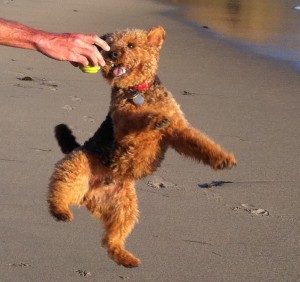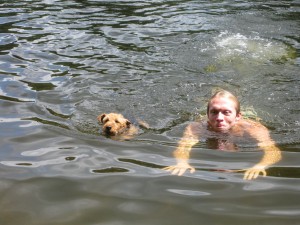 As our summer crawls to its inevitable conclusion and America’s children return to school, families must disallow the hectic nature of academia and extracurricular activities from contributing to reduced activity and emotional stimulation for our animal companions.
Obesity is clearly an epidemic affecting people and pets. According to the Association for Pet Obesity Prevention (APOP), an estimated 51% of dogs and cats (approximately 89 million pets) in the United States are overweight or obese.
Besides the unhealthy effect on the musculoskeletal system (bones, joints, tendons, and ligaments), carrying excessive body mass is unhealthy for the cardiovascular (heart and blood vessels), respiratory (lungs and trachea), endocrine (glands, such as the adrenals, liver, kidneys, and pancreas), and digestive organs (stomach and intestines).
The PPET (People Pets Exercising Together) Study, which was a partnership between Northwestern Memorial Hospital and Hill’s Pet Nutrition, showed that people who regularly exercised with their dog were better able to stick with their workout plan than dog-less participants.
As our summer crawls to its inevitable conclusion and America’s children return to school, families must disallow the hectic nature of academia and extracurricular activities from contributing to reduced activity and emotional stimulation for our animal companions.
Obesity is clearly an epidemic affecting people and pets. According to the Association for Pet Obesity Prevention (APOP), an estimated 51% of dogs and cats (approximately 89 million pets) in the United States are overweight or obese.
Besides the unhealthy effect on the musculoskeletal system (bones, joints, tendons, and ligaments), carrying excessive body mass is unhealthy for the cardiovascular (heart and blood vessels), respiratory (lungs and trachea), endocrine (glands, such as the adrenals, liver, kidneys, and pancreas), and digestive organs (stomach and intestines).
The PPET (People Pets Exercising Together) Study, which was a partnership between Northwestern Memorial Hospital and Hill’s Pet Nutrition, showed that people who regularly exercised with their dog were better able to stick with their workout plan than dog-less participants.
 Flexcin, makers of FlexPet joint supplement, recently conducted a study on dogs living in households where physical activity is reduced (due to a new human family member being brought home) have the unfortunate trend toward being overweight and suffering joint problems. This study’s findings can be extrapolated to parents’ apparent loss of time associated with the new school year’s commencement.
Help to prevent the “freshman 15” (or weight gain regardless of your academic class) by starting, maintaining, or intensifying a physical fitness program for both you and your dog.
Flexcin, makers of FlexPet joint supplement, recently conducted a study on dogs living in households where physical activity is reduced (due to a new human family member being brought home) have the unfortunate trend toward being overweight and suffering joint problems. This study’s findings can be extrapolated to parents’ apparent loss of time associated with the new school year’s commencement.
Help to prevent the “freshman 15” (or weight gain regardless of your academic class) by starting, maintaining, or intensifying a physical fitness program for both you and your dog.
 If you and your dog are new to exercising, begin with a consistently paced, low-impact activity, such as short walks or hikes, then increase the duration and challenge. Consistently paced activity has less injury causing potential than high-impact or high-intensity activities, such as sprinting and jumping.
Should your dog show any overt signs of distress while exercising (trouble breathing, weakness, fatigue, reluctance to move, lameness, etc), please schedule an examination with your veterinarian before further partaking in physical activity.
Getting outside and being active with your dog provides innumerable physical and emotional benefits for both the humans and their canine participants. At the start of this new school year, seek refuge in the stress reducing, family friendly benefits of participating in activity with your dog.
Please feel free to leave your comments or communicate with me through email (patrick@patrickmahaney.com) or Twitter (@PatrickMahaney).
Thank you for reading my article. To receive my next veterinary posting via email, please press the “Don’t Miss a Blog Post” button on the right upper corner of this page or follow this link.
Make sure to follow my adventures in veterinary medicine by friending Patrick Mahaney: Veterinarian Acupuncture Pain Management for Your Pets on Facebook.
Copyright of this article (2011) is owned by Dr. Patrick Mahaney, Veterinarian and Certified Veterinary Acupuncturist. Republishing any portion of this article must first be authorized by Dr. Patrick Mahaney. Republishing any portion of this article must first be authorized by Dr. Patrick Mahaney. Requests for republishing must be approved by Dr. Patrick Mahaney and received in written format.
If you and your dog are new to exercising, begin with a consistently paced, low-impact activity, such as short walks or hikes, then increase the duration and challenge. Consistently paced activity has less injury causing potential than high-impact or high-intensity activities, such as sprinting and jumping.
Should your dog show any overt signs of distress while exercising (trouble breathing, weakness, fatigue, reluctance to move, lameness, etc), please schedule an examination with your veterinarian before further partaking in physical activity.
Getting outside and being active with your dog provides innumerable physical and emotional benefits for both the humans and their canine participants. At the start of this new school year, seek refuge in the stress reducing, family friendly benefits of participating in activity with your dog.
Please feel free to leave your comments or communicate with me through email (patrick@patrickmahaney.com) or Twitter (@PatrickMahaney).
Thank you for reading my article. To receive my next veterinary posting via email, please press the “Don’t Miss a Blog Post” button on the right upper corner of this page or follow this link.
Make sure to follow my adventures in veterinary medicine by friending Patrick Mahaney: Veterinarian Acupuncture Pain Management for Your Pets on Facebook.
Copyright of this article (2011) is owned by Dr. Patrick Mahaney, Veterinarian and Certified Veterinary Acupuncturist. Republishing any portion of this article must first be authorized by Dr. Patrick Mahaney. Republishing any portion of this article must first be authorized by Dr. Patrick Mahaney. Requests for republishing must be approved by Dr. Patrick Mahaney and received in written format.